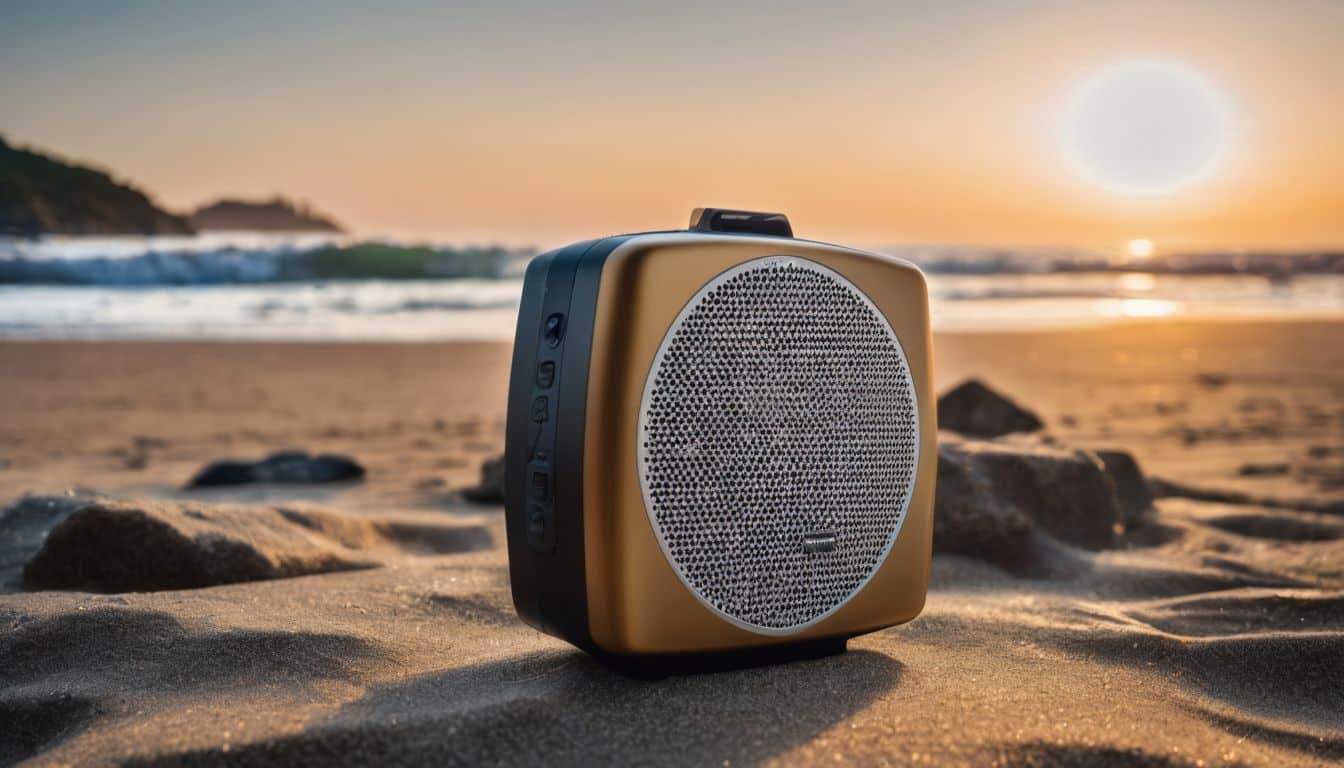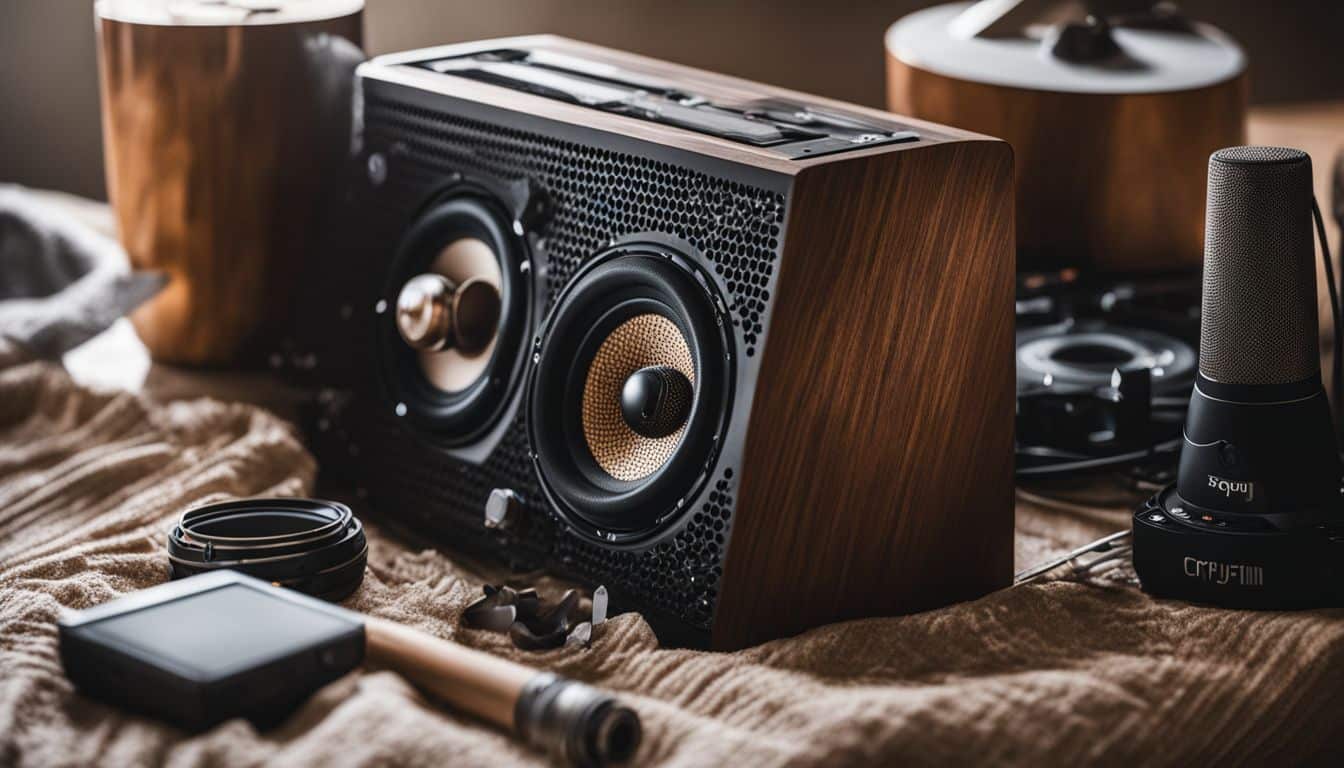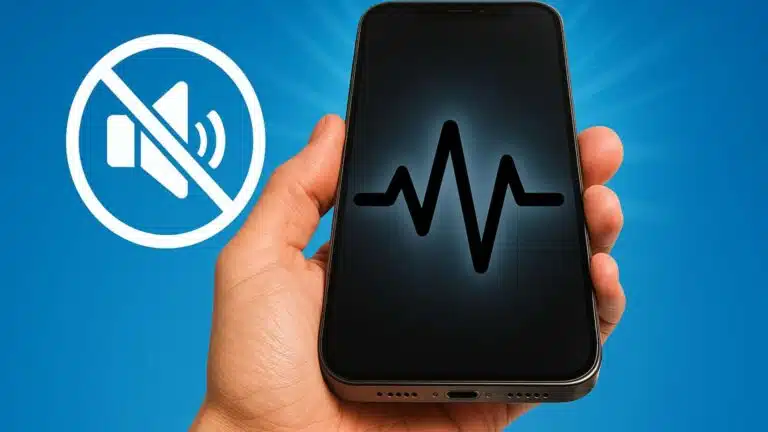
Water damage to your speaker can be a roadblock to enjoying your favorite tunes or podcasts. Imagine you’re at the beach and a rogue wave splashes over your phone; now, the audio sounds muffled.
Fear not, this guide will walk you through safe and effective ways to get that water out and restore clear sound. Keep reading for step-by-step solutions!
Steps to Get Water Out of Your Speaker

First, switch off the device to prevent any further damage. Then, eliminate any visible water on the surface of the speaker and use a vacuum cleaner or a hair dryer to remove excess moisture.
If necessary, disassemble the device to remove internal water and allow it to dry thoroughly before testing again.
Switch Off the Device
Immediately after your device comes into contact with water, the first and most critical step is to shut it off. This action is essential to prevent electrical currents from moving through the speaker, which could lead to a short circuit or more significant damage.
For iPhones or any smartphones, press and hold the power button until you see the option to slide to power off, then swipe it. If you’re wearing an Apple Watch or another wearable that’s gotten wet, use its side button to turn it off quickly.
Make sure not only to switch off your phone but also disconnect any charging cables if attached. Unplugging immediately helps safeguard against potential issues with the charging port that could arise from exposure to moisture.
Even if your device boasts water-resistant features like those found in an iPhone XR or Apple Watch Series 2, turning them off right away remains key in reducing risks of permanent damage.
Once you’ve powered down your gadget safely, gently pat dry any excess water using a soft cloth—focus on areas such as speakers and ports where water can easily seep in. Next up: tackling visible droplets before they have a chance to creep further inside your beloved tech companion.
Eliminate Visible Water
After powering down your device, the next crucial step is to tackle any visible water. Gently shake your phone to help droplets exit through ports like the charger or sim tray. Take a soft, absorbent cloth and dab around the speaker, being careful not to press too hard as this could push moisture further inside.
For stubborn water residue near the speaker grills, lightly use a cotton swab. This can wick away moisture without forcing it deeper into your phone’s internals. Also consider positioning your device in such a way that gravity aids in drawing out liquid; for example, rest it upright or on an incline if you’ve identified where the water entered.
Employing patience during this process is key – rushing might lead to more harm than good. Therefore, give each action time to work before moving onto tools like hairdryers or vacuum cleaners which are designed for more persistent dampness rather than surface wetness.
Keep up these efforts until all traces of visible water have been carefully dealt with.
Use Vacuum Cleaner
Grab your vacuum cleaner to tackle water in your speaker head-on. It’s a handy tool that can create strong suction, drawing out the moisture quickly and effectively from even the toughest spots.
Make sure you use a small nozzle attachment to focus the suction on the speaker area. Turn it on and carefully hover over the speaker grills for several minutes. This method is especially useful because it pulls water out without pushing it deeper into your device, which could cause further damage.
Keep moving gently around all openings of your phone or speaker while maintaining steady suction; patience here is key. After using the vacuum method, you might be ready to apply gentle heat with something like a hair dryer set on low – just be cautious not to overdo it!
Employ a Hair Dryer
After using a vacuum cleaner to remove as much water as possible from the speaker, employing a hair dryer can help further dry out any remaining moisture. Set the hair dryer to its lowest heat setting and hold it at least 12 inches away from the speaker.
Gently blow warm air into the speaker grill for several minutes, ensuring not to overheat the device.
Using a hair dryer helps evaporate any lingering water inside your phone’s speaker without causing damage. Just remember not to use high heat or place the hair dryer too close to the device, as excessive heat can harm sensitive electronic components.
Disassemble Device to Remove Internal Water
To remove water that has seeped inside your device, disassembling it is one effective method. Carefully open the device using appropriate tools and disconnect the components to access the internal areas where water might be trapped.
This step must be performed cautiously to avoid causing any further damage to the device.
As you take apart your device, be mindful of each component’s placement and ensure safe removal of any residual water or moisture. Once all parts are accessible, allow them to air dry thoroughly before reassembling the device.
Special Techniques for iPhone and Android

To address water damage in iPhone and Android speakers, special techniques such as playing low-frequency sounds or using the water eject shortcut can be employed. These specific methods are designed to help remove water from the device and prevent further damage to the speaker.
Play Low-Frequency Sound
To expel water from your phone speaker, try playing low-frequency sound. Low-frequency tones create vibrations that can help dislodge water droplets trapped within the speaker. This method is especially effective for pushing out moisture in hard-to-reach areas, helping to restore the clarity and functionality of your speaker.
Use Water Eject Shortcut
The Water Eject shortcut is a user-created solution available for both iPhone and Android devices. This convenient tool utilizes sound to assist in expelling water from the speaker of your phone, helping to prevent potential water damage.
Users can download the Water Eject shortcut from the Shortcuts app for iPhone and activate it to quickly begin the process of removing water from their device’s speaker, offering a practical and effective way to address this common issue.
By leveraging the power of low-frequency sound, this innovative shortcut provides an actionable solution that users can easily implement when faced with water-related concerns for their phones.
When to Contact a Repair Service
If your speaker continues to malfunction after attempting the above methods, it may be time to seek professional help. Water damage can cause long-term issues, so it’s best to contact a repair service if you’re unable to resolve the problem on your own.
How to Repair a Phone Speaker if Dropped in Water
If your phone’s speaker gets dropped in water, there are steps you can take to repair it. First, switch off the device immediately if it hasn’t already turned off due to water exposure.
Eliminate any visible water by shaking the phone gently with the speaker facing down and using a lint-free cloth to soak up excess moisture. Then, use a vacuum cleaner on low power or a hair dryer on cool setting to help remove residual water from the speaker.
For more serious cases, disassembling the phone may be necessary to thoroughly dry out internal components. Be cautious and refer to online guides or seek professional assistance if you’re not familiar with disassembly techniques for your specific phone model.
Remember that patience is crucial during this process as rushing could cause further damage.
Once these steps have been completed, test your phone’s speaker functionality before reassembling it completely. If needed, consider seeking assistance from a trusted repair service for thorough inspection and repairs beyond what can be done at home.
Conclusion
To ensure the safe removal of water from your speaker, follow these steps carefully. Switch off the device immediately to prevent any electrical damage. Eliminate visible water by gently shaking your phone with the speaker facing down and using a dry cloth to absorb moisture.
Use a vacuum cleaner or a hair dryer on a low setting to remove any remaining water from the speaker. If necessary, disassemble the device to access and remove internal water manually.
For iPhone or Android devices, consider employing special techniques such as playing low-frequency sound or using Water Eject shortcut for iPhones. Remember, it’s crucial to take preventive measures like using waterproof cases and keeping phones away from water sources in order to avoid future damage.
If these steps don’t resolve the issue, learn more about how to repair a phone speaker if dropped in water on our comprehensive guide.
FAQs
1. What’s the best way to remove water from my iPhone speaker?
The best method is using a low frequency sound, which can be played from apps you download from the App Store; they’re designed to eject water by playing specific tones through your iPhone’s speaker.
2. Can I use silica gel packs to dry out my phone speaker?
Yes, placing silica gel packets near your wet phone helps absorb moisture and humidity, making it an effective option for drying out speakers on devices like iPhones or Apple Watch Ultra.
3. Is there a safe way to use Siri to get water out of my speaker?
While Siri itself cannot remove water, you can ask Siri to open an app that plays sounds at a specific frequency which will help eject water safely from your iPhone 7 or later models’ speakers.
4. Are there any wearables that can resist getting water in their speakers?
Apple’s wearables like the Apple Watch Ultra are built with features that expel water automatically after submersion but always check PCMag.com or online guides for details on how each device works.
5. Will games or music apps help clear out liquid if my mobile phone gets wet?
Playing loud music or mobile games might push some moisture out of the speakers due to vibrations but this isn’t as efficient compared with using dedicated water ejection features available in certain apps.

